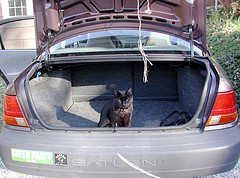Easing The Anxiety While Traveling With A Cat
Traveling with a cat can stressful for both you and your kitty, but there are some things you can do to ease the anxiety. Making your cat feel more secure will go a long way to improving your won travel experience.
Several things can help: continuous reassurance for one, getting your cat used to the travel experience is another, and nonprescription remedies, or in some cases, prescription medication.
For most cats who are not used to regular travel, travel equals anxiety.

Photo credit: Cat in trunk of car / CC 2.0
In some cases, just getting a cat into a carrier can result in blood loss.
Since most of us don't own a suit of armor, reducing your cat's anxiety is a self-preservation exercise, if nothing else.
To ease both your anxiety and your cat's, as the Boy Scouts say, "be prepared." Cats that travel well are generally well-socialized and already used to the travel experience. Some are leash trained.
So, it can be helpful not only to prepare yourself for the journey, but also to acclimate your cat to car travel. Many cats only ride in the car during stressful events... visits to the veterinarian, the groomer, moving from one home to another, or going to see the "Auntie" who has a dog your cat can't stand to be around.
Many cats are only put into their carriers during these times. Many cats don't even see the carrier until it's time to go to the vet.
And what happens? The amazing vanishing cat!
We may think we're doing our cats a favor by hiding the carrier away from them until it's time to go for one of these horrific rides. Unfortunately, that may actually increase the anxiety, and as soon as the carrier comes out, it's time to hide under the bed.
In truth, usually your cat knows before you do that he carrier is coming out, and is already hiding. We often think that cats can predict events, but more likely it's probably that your cat is sensing your anxiety over the event.
I wrote about easing anxiety in cats here. Although that was in response to litter box problems after moving to a new home, the basic information would apply to traveling with your cat as well.
Below are several things you can do that are specific to travel anxiety:
- Keep the carrier out
While at home, keep the carrier out in view of your cat at all times so that your cat doesn't fear it, and can keep her familiar scent on it. Your cat will feel more secure if the carrier is a familiar item and has her scent on it. - Use "Clipnosis"
There's a modified scruffing technique, called "Clipnosis" that is used for reducing anxiety in cats. You can use this to help get your cat into the carrier. Once your cat is inside the carrier, you can remove the clip. - Go for "good" car rides
Train your cat to accept car rides by slowly easing her into it. By going on rides that don't involve bad experiences, your cat may learn to accept, or even like riding in the car.
Start with very small trips, and gradually increase the ride time over a period of time. If you allow her a way to safely see out the window, she may learn to like all the interesting sights and smells.
At a minimum, though, try to make the experience as pleasurable as possible. Using treats or a favorite activity will allow your kitty to view car rides as a good experience.
If you leash train her, you could even go for a walk in the park. Some cats love to go for a walk, and the enticement of visiting a new and interesting place might turn your cat into a "cat travel expert." - Anxiety Medication
As mentioned in the cat travel checklist and explained in these tips, using Rescue Remedy and Feliway may help to reduce anxiety in your cat. If not, your vet may prescribe medication. - Crate training
Crate training a puppy is a fairly well-known practice, and crate training is therefore normally only thought of with respect to dogs, but it can make cat travel experiences much more pleasant.
From the point of view of a crate trained cat, the cat crate is a safe zone. Since your cat is safe inside the crate, she can take her safe zone with her, and feel much more secure when traveling. No more bloodshed when it comes time to leave the house. Less stress for you, less stress for your kitty. - Reassurance
As with all situations, ignore undesired behavior, and praise the good. Give your cat constant reassurance when she's feeling stressed and unsure of herself.
Kitty Anxiety Medication
Travel puts an extra stress burden on your kitty, and longer car rides can be especially stressful. If Rescue Remedy and Feliway don't do the trick to calm your cat, your vet can prescribe a mild tranquilizer... something like kitty Valium.
I don't like giving medication when it's not necessary, but there may be times when it's called for. I used this type of medication only once, at the beginning of a long trip across several states.
Some cat health problems may prevent your cat from taking these medications, so make sure you've got your cat's full medical history correct. The best vet to prescribe these medications is obviously your regular vet, but this is not always possible, especially in the case of emergency trips.
If your cat is healthy enough to take them, medication for anxiety can be especially helpful for:
- Taking the edge off at the beginning of a long trip.
- Cats who are skittish or have general anxiety problems.
- Cats who aren't used to car rides or travel.
- A cat who doesn't handle traveling well despite repeated experiences.
If you ease your cat into it and take regular car rides together, traveling with your cat may become more enjoyable for the both of you!
Do you have experience traveling with a cat? Submit your stories, ideas, and tips.



Comments: What do you think?
Have your say about what you just read. Leave me a comment in the box below.